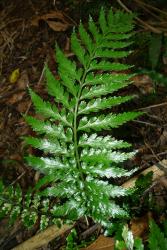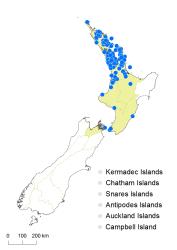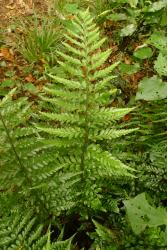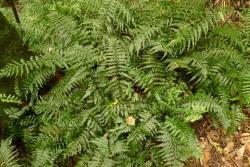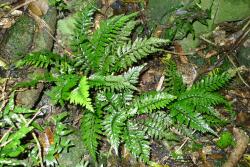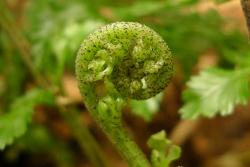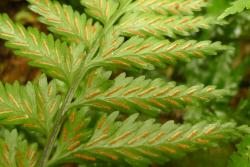Terrestrial or rupestral ferns, or rarely low epiphytes. Rhizomes creeping, up to 110 mm long (in herbarium material), up to 5 mm diameter, bearing scales, stoloniferous. Rhizome scales ovate, 0.8–2.5 mm long, 0.5–1.2 mm wide, dark brown, clathrate. Fronds 210–820 mm long (rarely only 100 mm long). Stipes 60–280 mm long (rarely only 25 mm long), pale brown abaxially and proximally, green adaxially and distally, bearing ovate scales with thick cell walls throughout. Rachises green, scaly, winged in the distal half. Laminae 1–2-pinnate-pinnatifid or 2-pinnatifid, ovate or elliptic, tapering gradually to the apex, 140–590 mm long (rarely only 70 mm long), 35–240 mm wide (rarely only 22 mm wide), glossy light green on adaxial surface, dull pale green on abaxial surface, herbaceous, bearing scattered scales on both surfaces, lacking hairs. Primary pinnae in 8–25 pairs below pinnatifid apex, not or only slightly overlapping; proximal primary pinnae ovate or narrowly ovate, those at mid-lamina narrowly ovate; the longest at or below the middle, 20–150 mm long (rarely only 15 mm long), 8–40 mm wide (rarely only 6 mm wide), apices acuminate, bases more or less stalked; costae of primary pinnae winged throughout except occasionally near junction with rachis. Proximal primary pinnae divided into 1–6 pairs of secondary pinnae or lobes and a long pinnatifid apical segment, winged for most or all of the length; the basal acroscopic secondary pinna or lobe elliptic or ovate, 7–27 mm long (rarely only 4 mm), 2–14 mm wide, apices obtuse, margins incised, bases adnate or stalked in the most divided fronds. Sori nearer mid-vein than margin; indusia 2–10 mm long, curved away from midrib; free margins of indusia entire. Mean spore size 38–42 μm long, 24–29 μm wide; perispores pale and not prominently patterned.
Asplenium lamprophyllum is characterised by its creeping rhizomes, thick-walled scales, glossy green adaxial lamina surfaces, and characteristic smell of oil of wintergreen when crushed. It is similar to A. bulbiferum but distinguished by its creeping rhizome, thick-walled scales, glossy and less divided laminae, longer sori (2–10 mm cf. 2–4 mm long), and absence of bulbils.
The specimens at the extreme lower end of the range of variation in the description are very small fronds found at the southern margin of the species distribution (e.g. WELT P027345, CHR 553588).
Rare aberrant forms are found with much longer and more divided primary pinnae, and narrower secondary pinnae.
North Island: Northland, Auckland, Volcanic Plateau, Taranaki, Southern North Island.
South Island: Sounds-Nelson.
Altitudinal range: 10–600 m.
Asplenium lamprophyllum occurs in the North Island from Te Paki through Northland and Auckland to the north Taranaki coast, the western Bay of Plenty and Rotorua district, with outlying populations recorded from Wanganui, Whangaehu in Hawke’s Bay, and Wellington. It grows in coastal and lowland areas from near sea level up to 600 m in the Kaimāī Ranges. In the South Island, it is known from one collection on Arapawa Island (CHR 553588) and a poorly localised 19th century record from the Westport area (WELT P028288), not mapped here.
Asplenium lamprophyllum is usually a terrestrial fern, or rarely a low epiphyte, found in open podocarp and broadleaved forest, where it may carpet extensive areas over rocks and boulders, rotting logs, clay banks, and stream banks. It is found on steep slopes and well-drained soils, occurring on a variety of rock types, including lava, rhyolite, ignimbrite, and limestone.
Asplenium lamprophyllum occasionally hybridises with A. bulbiferum (Brownsey 1977a).
n = 72 (Brownlie 1961; Brownsey 1977b).



